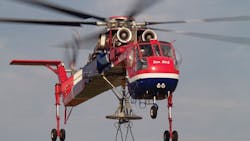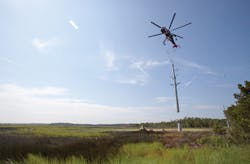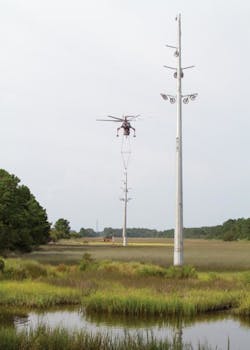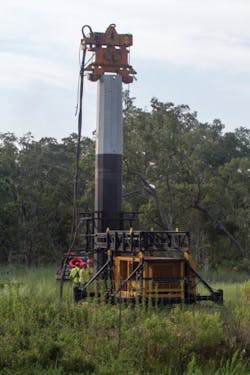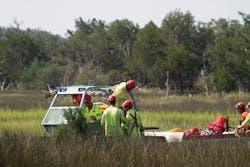GTC Builds Transmission Across a Salt Marsh
Safety is the top priority during the construction of any high-voltage power line. For Georgia Transmission Corp. (GTC), safety took on a greater meaning than ever as the cooperative that builds and maintains infrastructure on behalf of Georgia’s electric membership cooperatives (EMCs) undertook construction of a 115-kV line that crossed a pristine salt marsh. This project upped the ante by requiring the project team to consider the safety of the natural environment, motorists along a major East Coast interstate highway, state-protected property and aircraft that aided in innovative construction.
With a thorough planning process, deep involvement with the local EMC, and close collaboration with state and federal regulatory agencies from the Georgia Department of Natural Resources (DNR) to the Army Corps of Engineers, GTC was able to complete a 12.2-mile (19.6-km), 115-kV transmission line on Georgia’s coast to shore up electric reliability and support an ongoing wave of economic development in the region.
System Fortification Needed
The economy of coastal Georgia is growing as more businesses seek to expand their operations, and steady growth at the Port of Savannah is yielding economic dividends for the entire state. Because reliable electric service must be in place to meet the needs of area communities and to attract and nurture continued economic development, GTC and Coastal Electric Cooperative, the local EMC, identified the need for an additional electric transmission line to reinforce reliability on a radial transmission system and help to prevent outages in the region.
In 2007, GTC released a project for a transmission line that would connect the Burnt Church Road Substation in Bryan County, Georgia, to the Tradeport Industrial Park Substation in Liberty County, Georgia. In addition, Coastal Electric Cooperative would build accompanying distribution lines on the new transmission infrastructure to support distribution load shifting during substation outages.
The existing system serving the region includes a northern tier of substations and a southern tier of substations. These substations use radial lines connecting one another to a single point of service. If one portion of the line fails, power is lost to the remainder of the regional system. As a result, GTC wanted to connect the northern group of substations with the southern group of substations to create a dual feed.
The new transmission line would reinforce the existing infrastructure in the coastal region, prevent overloads and ensure reliable electric service to Coastal Electric customers, including a major retail distribution center and an aeronautical manufacturing company. In addition to this existing commercial development, planned development and land-use designations promised further use of the already taxed system.
Siting in the Salt Marsh
Siting challenges were immediately apparent when the project team first considered where to route the line. The route would inevitably cross through portions of the coastal salt marsh, one of Georgia’s most sensitive and strictly protected environmental areas.
When routing a new line, GTC considers existing land use, environmental conditions, historic and cultural resources, population centers, existing transmission corridors, cost, engineering factors, community input and specific needs of the electrical system to ultimately select the route that is the most logical choice for the needs of the region. The cooperative relies on a nationally recognized siting methodology and software developed by GTC and the Electric Power Research Institute (EPRI) to help identify the preferred corridors for consideration.
Originally, the transmission line was planned to connect the system’s easternmost substation and the Tradeport Substation. However, this plan would have required crossing through an even greater portion of wetlands and salt marsh. As a result, the decision was made to connect the Burnt Church Substation instead.
While the DNR initially suggested total avoidance of the salt marsh, the resulting route would have been significantly longer. Not only would a longer route have increased the cost, but it also would have been much closer to the existing facilities of the radial system, which would have reduced the reliability benefits the new line was meant to achieve. Further, this option would have required more poles and more construction, meaning more impact on the environment, local communities and neighborhoods.
The DNR also requested an evaluation of building the transmission line underground. This option actually presented an even more intrusive approach, as conduits to house underground cabling and the required periodic aboveground cable splice vaults would have resulted in significant disturbance to the natural landscape and coastal marshlands.
The final route choice to connect the Burnt Church Substation to the Tradeport Substation presented the most efficient route with the least impact on the environment and alignment with other routing considerations. The final route crosses approximately 4 miles (6.4 km) of salt marsh, and the majority of the remainder of the transmission line parallels roads, primarily the Interstate 95 corridor.
Heritage Preserve Property
As the project team proceeded with the routing process, GTC faced another unforeseen challenge: A portion of the planned route was classified as Heritage Preserve by the state of Georgia. Heritage property is state owned and classified under some of the most restrictive usage constraints; there were no provisions for accessing this land and the restriction was absolute.
To provide a means for utility corridors to cross the Heritage Preserve property required legislative action, a process that took approximately a year to complete. First, the DNR sponsored and approved a change of use for the land that allowed construction of the transmission line. The DNR held a public hearing and then drafted legislation and presented it to the Georgia General Assembly. The legislation passed, granting access to the property.
Additionally, a revocable license was granted to GTC to access a 100-ft (30-m)-wide portion of the Heritage Preserve and salt marsh.
The Road to Construction
The natural environment was not the only challenge the GTC team faced. The project also required road permits from Bryan County, Liberty County and the Georgia Department of Transportation (DOT). GTC worked closely with the Georgia DOT to secure permits for temporary access on I-95.
The Georgia DOT permit allowed GTC limited access to the salt marsh through the I-95 rights-of-way maintained by the state agency. The permit required rigorous safety measures, including a detailed traffic-control plan designed to slow traffic and keep it moving at a steady pace.
Drivers encountered “utility work ahead” signs along both sides of the interstate within a mile of construction and the flashing lights of local police vehicles located northbound and southbound to prevent drivers from stopping and watching the construction. While standard line construction might not be a sight that stopped traffic, it is not every day a 70-ft (21-m) skycrane can be seen lifting 80-ft to 100-ft (24-m to 30-m) power poles next to the interstate.
Salt Marsh Challenges
Georgia’s salt marshes play a unique role in maintaining the balance of the state’s coastal estuaries. They are recognized as one of the most valuable natural resources, with great scientific, ecological, commercial and recreational value. As a result, the DNR maintains strict regulations and limited access to the salt marshes to preserve and protect these natural resources. In compliance with these regulations, the team pursued a construction technique that was a first in the state of Georgia: air-lifted steel poles and slip-jointed vibratory caissons placed in the salt marsh using powerful vibratory hammers. This course of action required engineers to be exceptionally precise with the design and execution.
First, GTC took nine soil samples along the 4-mile (6.4-km) stretch in the salt marsh to aid in pole design. The composition of the soil would determine the appropriate depths for setting the steel vibratory caissons to ensure a strong foundation and stability.
While nine soil samples seemed adequate to develop a soil profile, engineers quickly discovered wide variation among the samples. The tidal nature of the salt marsh meant there would be further opportunity for a varied soil composition. Engineers used the samples to ascertain the proper caisson depths. With literal shifting sands in the construction environment, engineers called on years of experience to project the caisson lengths and placement within the narrow margin for error.
Construction Lifts Off
With environmental, transportation and engineering hurdles cleared, it was time to take to the skies for construction. The primary contractor for the project was Irby Construction Co. and the aerial subcontractor was Erickson Air-Crane. The company used a Sikorsky S-64 Skycrane to position foundations, and structure segments and equipment to preserve the salt marsh and surrounding ecological resources. The S-64 is manned with a pilot, copilot and engineer.
The payload capacity for the Skycrane is 25,000 lb (11,340 kg), with a maximum takeoff weight of 42,000 lb (19,051 kg). The Skycrane carried mats, a power pack, a vibratory hammer, vibratory caissons and the transmission poles into the salt marsh during the construction period.
With the equipment in place, the Skycrane flew caissons and steel poles from the material yard along I-95 to the construction sites. The caissons were eased into the wetlands using a vibratory hammer, which is essentially a weight on hydraulic pistons housed in a rectangular case. Inside the case, the weight oscillates, creating downforce that drives the caisson into the soil. The movement of the weight is manually controlled. The faster the weight moves inside the cabinet, the more vibration and downforce are created. Using this method, most of the 32 caissons were driven into the ground, each in less than five minutes with minimal soil displacement.
Additionally, the construction team used a Hydratek D2488B, a multipurpose, load-dispersing amphibious vehicle, to transport personnel around the salt marsh while leaving the lightest footprint possible. The 24-inch (610-mm) over-the-tire rubber track system exerts just 1 psi.
Throughout the construction process, GTC and Coastal Electric upheld their commitment to tread lightly and minimize disturbance to the salt marshes, spending only 10 days in the protected areas. For the remainder of the project, an existing roadway corridor was used with little to no environmental impact.
Project Complete
While this innovative salt marsh construction was a first for GTC, the project team relied on tenured experts and collaborated with the appropriate agencies and construction partners to meet the unique challenges presented by the Burnt Church-to-Tradeport transmission line.
In the end, GTC adapted to dozens of complex circumstances to complete a top-notch project that improves reliability for existing customers and enables future economic development in the region, all while protecting the environment. The pioneering techniques employed and the cooperative approach between GTC, Coastal Electric Cooperative, federal and state agencies, regulators and stakeholders stands as a model for future projects to ensure the construction of efficient, safe and environmentally responsible transmission lines.
Vince Howard ([email protected]) is the manager of environmental services for Georgia Transmission Corp. He has been with Georgia Transmission Corp. since it was formed in 1997. Prior to that, he was with Oglethorpe Power Co. for almost 10 years. He has more than 40 years of experience working in the environmental compliance arena.
Karl G. Ledford ([email protected]) is the land and legal rights coordinator for Georgia Transmission Corp. and has more than 30 years of industry experience.
Ashok Padman ([email protected]) is a transmission line engineer with Georgia Transmission Corp. He has five years of experience in transmission line design and more than 30 years of experience in structural engineering.
Herb Payne ([email protected]) is a project manager for bulk transmission line projects for Georgia Transmission Corp. He has more than 35 years of industry experience and is a member of the American Society of Civil Engineers.
Companies mentioned:
Coastal Electric Cooperative | www.coastalemc.com
Georgia DNR | www.gadnr.org
Electric Power Research Institute | www.epri.com
Erickson Air-Crane | www.ericksonaircrane.com
Georgia Transmission Corp. | www.gatrans.com
Irby Construction Co. | www.irbyconst.com
